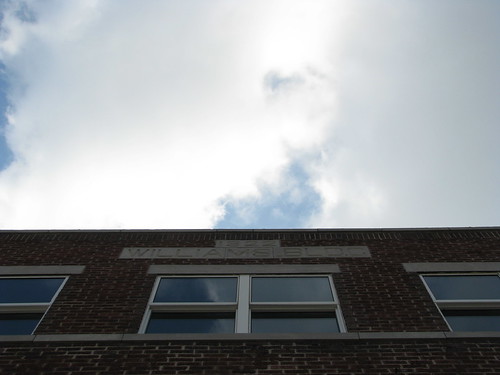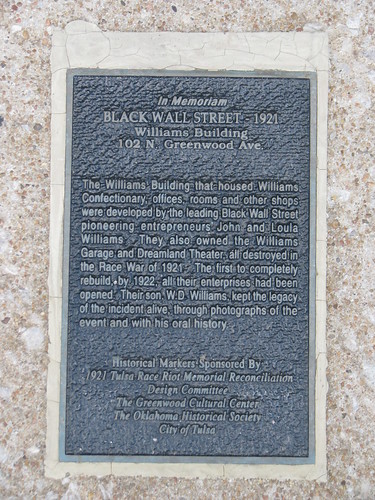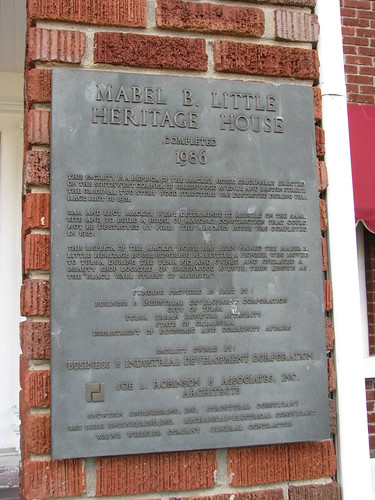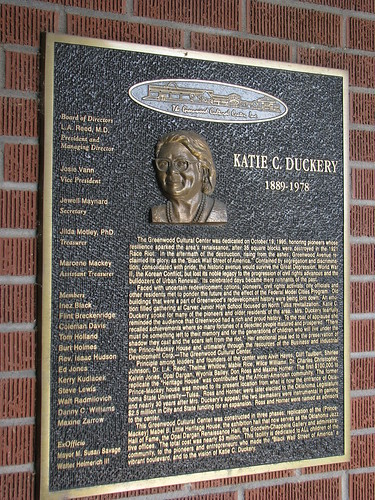Signs of Greenwood's rebuilding
In my Ignite Tulsa talk on the "Greenwood Gap," I mentioned in passing the physical indications of the rebuilding and flourishing of Tulsa's African-American district after it was burned in 1921 by a white mob. I would have included photos of some of those signs, and I had some that I'd taken, but I couldn't find them, so earlier today I took some more, finding dates on buildings, on cornerstones, and on commemorative plaques that tell the story of Greenwood's post-1921 resurgence. (Click that link to view the set on Flickr.)
The churches, and the dates on their cornerstones, beg the question: If there wasn't a rebuilt neighborhood nearby, why were the churches rebuilt there? (Further, why did congregations build newer fancier buildings in the late '50s and early '60s?) (NOTE: In the olden days, churches were built in neighborhoods and people traveled short distances to church. They weren't set up like consumer-oriented big-box stores with huge parking lots, isolated from neighborhoods.)
Here's the Williams Building at 102 N. Greenwood Ave., rebuilt in 1922, after the building previously on that site was destroyed by the riot. Note the year above the name of the building.
After the jump, you'll see the plaque set in the sidewalk next to the building, and two more plaques -- one on the entrance to the Mabel B. Little Heritage House and the other on the entrance to the Greenwood Cultural Center.
"The Williams Building that housed Williams Confectionary, offices, rooms, and other shops were developed by the leading Black Wall Street pioneering entrepreneurs John and Loula Williams. They also owned the Williams Garage and Dreamland Theater, all destroyed in the Race War of 1921. The first to completely rebuild -- by 1922, all their enterprises had been opened. Their son, W. D. Williams, kept the legacy of the incident alive, through photographs of the event and with his oral history."
Mabel B. Little Heritage House Completed 1986This facility is a replica of the Mackey House, originally erected on the southwest corner of Greenwood Avenue and Easton Street. The original two story wood structure was destroyed during the race riot of 1921.Sam and Lucy Mackey were determined to rebuild on the same site and to build a house of masonry construction that could not be destroyed by fire. The masonry house was completed in 1927.
This replica of the Mackey house has been named the Mabel B. Little Heritage House, honoring Mrs. Little, a pioneer who moved to Tulsa during the year 1913 and owned and operated a beauty shop located on Greenwood Avenue, then known as the "Black Wall Street of America."
This plaque stands at the south entrance to the Greenwood Cultural Center. (Emphasis added.)
Katie C. Duckery
1889-1978The Greenwood Cultural Center was dedicated on October 9, 1995, honoring pioneers whose resilience sparked the area's renaissance, after 35 square blocks were destroyed in the 1921 Race Riot. In the aftermath of the destruction, rising from the ashes, Greenwood Avenue reclaimed its glory, as the "Black Wall Street of America." Contained by segregation and discrimination, consolidated with pride, the historic avenue would survive the Great Depression, World War II, the Korean Conflict, but lost its noble legacy to the progression of civil rights advances and the bulldozers of Urban Renewal. Its celebrated days became mere remnants of the past.
Faced with uncertain redevelopment options, pioneers, civil rights activists, city officials and other residents met to ponder the future and the effect of the Federal Model Cities Program. Old buildings that were a part of Greenwood's redevelopment history were being torn down. An emotion-filled gathering at Carver Junior High School focused on North Tulsa revitalilzation. Katie C. Duckery spoke for many of the pioneers and older residents of the area. Mrs. Duckery tearfully reminded the audience that Greenwood had a rich and proud history. To the roar of applause she recalled achievements where so many fortunes of a dejected people matured and prospered. "There must be something left to their memory and for th egenerations of children who will live under the shadow they cast and the scars left from the riot." Her emotional plea led to the preservation of the Prince-Mackey House and ultimately through the resources of the Business and Industrial Development Corp. -- The Greenwood Cultural Center.
Principle among leaders and founders of the center were Alvin Hayes, Cliff Taulbert, Shirlee Johnson, Dr. L. A. Reed, Thelma Whitlow, Mable RIce, Wilce Williams, Dr. Charles Christopher, Kelvin Jones, Opal Dargan, Wyonia Bailey, Don Ross and Maxine Horner. The first $100,000 to replicate the "Heritage House" was contributed by the African-American community. the former Prince-Mackey house was moved to its present location from what is now the entrance of Oklahoma State University-Tulsa. Ross and Horner, were later elected to the Oklahoma Legislature and nearly 30 years after Mrs. Duckery's appeal, the two lawmakers were instrumental in gaining $2.5 million in City and State funding for an expansion. Ross and Horner were named as advisors to the center.
This Greenwood Cultural Center was constructed in three phases: replication of the (Prince-Mackey) Mabel B. Little Heritage House, the exhibition hall that now serves as the Oklahoma Jazz Hall of Fame, the Opal Dargan Renaissance Hall, the Goodwin-Chappelle Gallery and administrative offices. The total cost was nearly $3 million. The facility is dedicated to ALL children of the community, to the pioneers and entrepreneurs who made the "Black Wall Street of America" a vibrant boulevard, and to the vision of Katie C. Duckery.
1 TrackBacks
Listed below are links to blogs that reference this entry: Signs of Greenwood's rebuilding.
TrackBack URL for this entry: https://www.batesline.com/cgi-bin/mt/mt-tb.cgi/5296
Today is the 90th anniversary of a white mob's attack on Tulsa's African-American district, known as Greenwood after its principal avenue. The attack, which began the evening of May 31, 1921, killed hundreds and left thousands wounded and homeless. Onc... Read More



